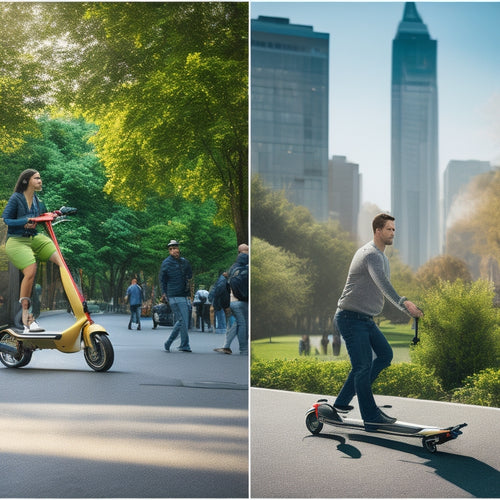
Designing the Future of Urban Mobility Systems
Share
As you reimagine urban mobility systems, you're tasked with integrating electric vehicle infrastructure, sustainable design, and data-driven insights to create a seamless travel experience. By 2030, you'll need to deploy approximately 20 million public charging points globally, with the US requiring around 1.2 million. Smart grids will manage fluctuating energy demands, while high-power charging corridors will enable long-distance EV travel. You'll balance urban planning, transportation engineering, and data analytics to minimize environmental impact. As you push the boundaries of innovation, you'll uncover more opportunities to transform urban mobility systems and create a greener, more efficient future.
Key Takeaways
• Effective urban mobility systems require integration of electric vehicle infrastructure, smart grids, and data analytics to minimize environmental impact.
• Urban planning strategies should prioritize pedestrian-friendly spaces, green corridors, and mixed-use development to reduce congestion and emissions.
• Predictive analytics can optimize traffic routing, signal control, and public transit systems to enhance efficiency and reduce congestion in urban areas.
• A seamless travel experience can be achieved by integrating multi-modal transportation systems and promoting easy switching between modes.
• Future urban mobility systems should prioritize social equity, rural connectivity, and appealing public transit to create a sustainable and efficient transportation network.
Electric Vehicle Infrastructure Needs
As the world shifts towards widespread electric vehicle (EV) adoption, you'll need approximately 20 million public charging points globally by 2030, with the United States requiring around 1.2 million, to support the projected 7 million EVs on American roads.
This massive infrastructure overhaul will require strategic planning to guarantee seamless vehicle charging. You'll need to take into account the strain on grid capacity, as EVs will account for a significant increase in electricity demand. In fact, a single EV can consume up to 3 times the electricity of an average American home.
To mitigate this, you'll need to invest in smart grids, capable of managing fluctuating energy demands and optimizing energy distribution. Additionally, you'll need to develop high-power charging corridors along highways, enabling long-distance EV travel.
Sustainable Mobility System Design
You'll need to integrate urban planning, transportation engineering, and data analytics to design a sustainable mobility system that optimizes the flow of people, goods, and services while minimizing environmental impact. This multidisciplinary approach will allow you to create a system that's not only efficient but also environmentally friendly.
Community engagement is vital in this process, as it guarantees that the needs of all stakeholders are taken into account. By involving local residents, businesses, and commuters, you can design a system that meets the unique needs of your community.
One critical aspect of sustainable mobility system design is the incorporation of bike-friendly infrastructure. By designing roads and pathways that prioritize cyclist safety and accessibility, you can encourage a shift away from personal vehicles and towards more environmentally friendly modes of transportation. This, in turn, can reduce congestion, air pollution, and greenhouse gas emissions.
Urban Planning for Efficient Traffic
To optimize urban traffic flow, designers must leverage cutting-edge urban planning strategies, integrating data-driven insights with spatial analysis to create smart, adaptive traffic management systems.
As you design urban spaces, you'll need to take into account the intricate relationships between land use, urban density, and traffic congestion. By analyzing road networks and identifying bottlenecks, you can implement intelligent traffic flow management systems that adapt to real-time conditions.
Effective parking management is also essential, as it can greatly impact traffic flow and safety. You'll need to balance street design with traffic safety considerations, ensuring that pedestrians, cyclists, and motorists coexist harmoniously.
Green Transportation Revolution Ahead
By 2050, electric and self-driving vehicles will dominate urban roads, catalyzing a green transportation revolution that transforms the urban mobility landscape. As you step into this futuristic world, you'll witness a significant reduction in greenhouse gas emissions, thanks to the widespread adoption of eco-friendly transportation solutions. The carbon pricing mechanism will play a vital role in incentivizing this shift, making environmentally conscious choices more affordable and accessible to the masses.
You'll notice that cities are designing infrastructure that prioritizes pedestrian-friendly spaces, cycling lanes, and green corridors, promoting eco-friendly lifestyles. The urban planning strategy will focus on compact, mixed-use developments, reducing the need for lengthy commutes and encouraging shared mobility services. As a result, you'll experience a notable decrease in air pollution, noise pollution, and urban congestion.
The green transportation revolution won't only transform the urban mobility landscape but also contribute to a healthier, more sustainable quality of life. By embracing this revolution, you'll be part of a global movement towards a cleaner, more environmentally responsible future.
Smart City Infrastructure Development
As you design smart city infrastructure, you'll need to develop urban planning strategies that prioritize efficient land use, mixed-use development, and pedestrian-friendly spaces.
You'll also need to optimize your mobility network by integrating modes of transportation, such as buses, trains, and bike-share systems, to reduce congestion and increase accessibility.
Urban Planning Strategies
You'll need to integrate multi-modal transportation systems, green spaces, and data-driven infrastructure to create a seamless and sustainable urban mobility experience. This is where urban planning strategies come into play.
By incorporating pedestrian-friendly design principles, you'll encourage walking and cycling, reducing reliance on personal vehicles and promoting a healthier environment. Urban revitalization is key, as it allows you to repurpose underutilized spaces and create vibrant public areas that foster community engagement.
To achieve this, you'll need to adopt a holistic approach, considering the social, economic, and environmental impacts of your design. This might involve implementing smart traffic management systems, optimizing public transportation routes, and integrating green infrastructure, such as parks and green roofs, to mitigate the urban heat island effect.
Mobility Network Optimization
Optimizing urban mobility networks requires integrating intelligent transportation systems, advanced data analytics, and IoT-enabled infrastructure to create a responsive, efficient, and adaptive transportation ecosystem. As you design the future of urban mobility, you'll need to prioritize route optimization and node clustering to minimize congestion and reduce travel times.
To achieve this, you can leverage advanced algorithms and data analytics to identify bottlenecks in the network and optimize traffic signal control. This will enable you to dynamically adjust traffic signal timings to prioritize critical routes and minimize congestion.
| Optimization Strategy | Benefits | Challenges |
|---|---|---|
| Route Prioritization | Reduces congestion, minimizes travel times | Requires real-time traffic data, complex algorithmic models |
| Node Clustering | Improves network resilience, reduces traffic signals | Requires accurate traffic forecasting, complex network analysis |
| Dynamic Signal Control | Optimizes traffic signal timings, reduces congestion | Requires real-time traffic data, complex algorithmic models |
Future-Proofing Urban Transportation
As you envision the future of urban mobility, you're tasked with designing a transportation system that's adaptable to emerging technologies and shifting demographics. To achieve this, you'll need to prioritize smart traffic management that optimizes traffic flow and reduces congestion, while also developing efficient public transit systems that integrate seamlessly with other modes of transportation.
Smart Traffic Management
As you navigate the complexities of urban mobility, you'll find that smart traffic management is an essential component of future-proofing urban transportation. By leveraging advanced technologies like IoT sensors, artificial intelligence, and real-time data analytics, cities can proactively manage traffic flow, reducing congestion and emissions while enhancing the overall commuter experience.
To achieve this, cities can implement intelligent traffic management systems that utilize real-time routing and dynamic traffic signal control. This allows for optimized traffic light timing, reducing congestion and minimizing travel times.
| Technology | Benefits |
|---|---|
| IoT Sensors | Real-time traffic monitoring and data analysis |
| Artificial Intelligence | Predictive analytics for optimized traffic routing |
| Real-time Data Analytics | Enhanced traffic signal control and optimization |
| Intelligent Intersections | Dynamic traffic signal control and reduced congestion |
Efficient Public Transit
By integrating smart traffic management with efficient public transit systems, you can create a seamless travel experience, where commuters can easily switch between modes of transportation, reducing reliance on personal vehicles and decreasing congestion in urban areas.
This integration enables you to optimize routes, schedules, and capacities in real-time, ensuring that public transit is reliable, efficient, and appealing to users.
To further enhance the system's efficiency, you can implement late-night services, catering to the needs of late-shift workers, students, and social enthusiasts.
Additionally, investing in rural connectivity can extend the benefits of efficient public transit to surrounding rural areas, promoting social equity and bridging the gap between urban and rural communities.
Frequently Asked Questions
How Will Autonomous Vehicles Impact Urban Traffic Congestion and Safety?
As you consider the impact of autonomous vehicles, you'll notice they'll likely alter traffic patterns, reducing congestion and accidents, which could lead to changes in vehicle insurance rates and policies, ultimately transforming urban mobility.
Can Green Spaces Be Integrated Into Urban Mobility System Design?
'Like a refreshing change, you're considering integrating green spaces into urban mobility design. By incorporating urban forestry, green corridors, and eco-friendly infrastructure, you'll create sustainable landscapes and park connectivity, improving air quality and quality of life.'
What Role Do Pedestrians and Cyclists Play in Future Urban Mobility?
As you reimagine urban mobility, you'll find pedestrians and cyclists playing a crucial role, relying on pedestrian infrastructure, cycling networks, safe crossings, and bike sharing systems to thrive, even amidst urban highways.
How Will Urban Mobility Systems Accommodate Increasing Urban Populations?
As you navigate the future of urban mobility, consider this: by 2050, 66% of the global population will live in cities. To accommodate this growth, you'll need to prioritize dense, mixed-use development, efficient public transit, and innovative land use strategies to curb urban sprawl.
Can Urban Mobility Systems Be Designed for Social Equity and Accessibility?
As you reimagine urban mobility, you'll prioritize transportation justice by incorporating community engagement, ensuring inclusive designs that amplify marginalized voices and foster accessible, equitable transportation for all.
Related Posts
-

Why Opt for These Affordable E-Scooter Alternatives?
You're tired of overspending on transportation and harming the environment, which is why you're considering affordabl...
-

7 Best RV Battery Charging Panels for Your Adventures
You're searching for reliable and efficient solar charging solutions to power your RV battery on the go. Explore top-...
-

What Are the Safety Certification Requirements?
You need to make sure your electric scooter meets rigorous safety certification requirements to guarantee a safe ride...


